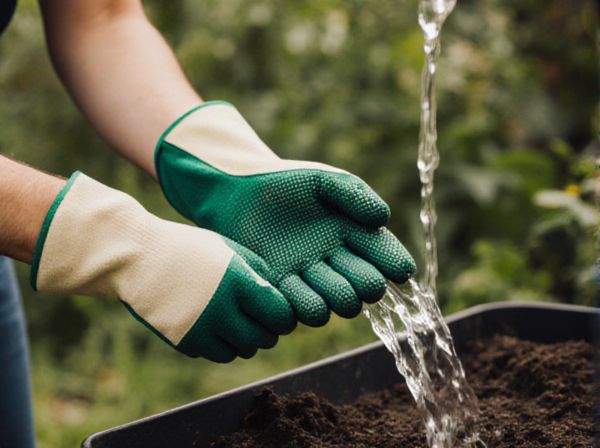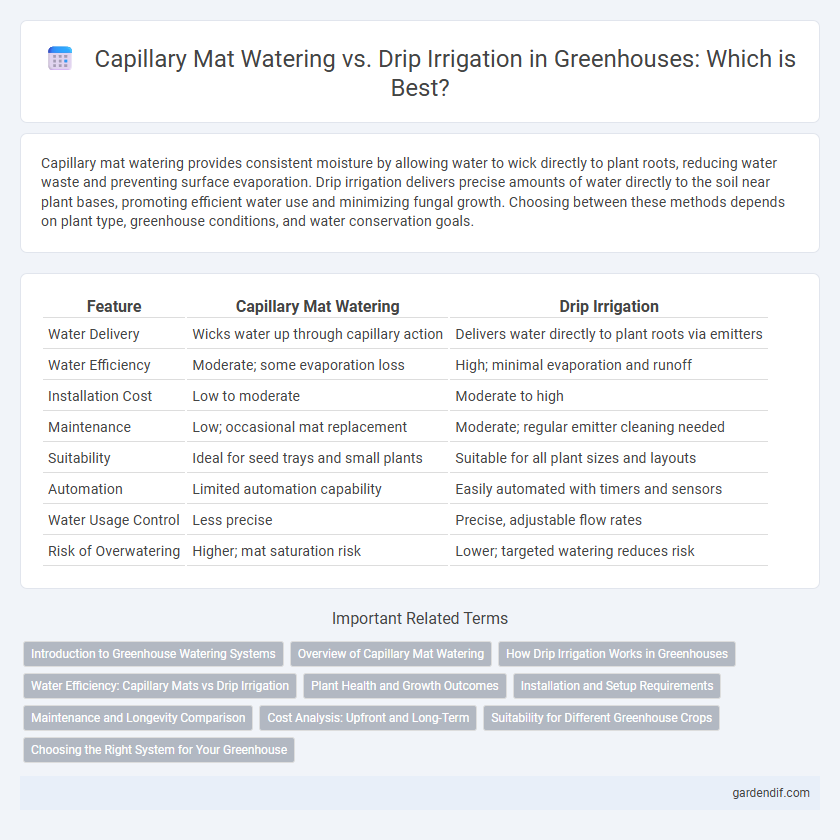
Capillary mat watering vs Drip irrigation Illustration
Capillary mat watering provides consistent moisture by allowing water to wick directly to plant roots, reducing water waste and preventing surface evaporation. Drip irrigation delivers precise amounts of water directly to the soil near plant bases, promoting efficient water use and minimizing fungal growth. Choosing between these methods depends on plant type, greenhouse conditions, and water conservation goals.
Table of Comparison
| Feature | Capillary Mat Watering | Drip Irrigation |
|---|---|---|
| Water Delivery | Wicks water up through capillary action | Delivers water directly to plant roots via emitters |
| Water Efficiency | Moderate; some evaporation loss | High; minimal evaporation and runoff |
| Installation Cost | Low to moderate | Moderate to high |
| Maintenance | Low; occasional mat replacement | Moderate; regular emitter cleaning needed |
| Suitability | Ideal for seed trays and small plants | Suitable for all plant sizes and layouts |
| Automation | Limited automation capability | Easily automated with timers and sensors |
| Water Usage Control | Less precise | Precise, adjustable flow rates |
| Risk of Overwatering | Higher; mat saturation risk | Lower; targeted watering reduces risk |
Introduction to Greenhouse Watering Systems
Capillary mat watering provides uniform moisture through a porous mat that allows plants to absorb water directly at the root zone, reducing water waste in greenhouse environments. Drip irrigation delivers precise water droplets directly to individual plant roots through a network of tubes and emitters, enhancing water efficiency and minimizing evaporation. Both systems optimize water use but differ in application methods suitable for various greenhouse crop types and growth stages.
Overview of Capillary Mat Watering
Capillary mat watering uses absorbent mats placed beneath plants to deliver water uniformly through capillary action, ensuring consistent moisture levels without overwatering. This method reduces water waste by promoting efficient uptake directly by plant roots and minimizes labor compared to drip irrigation systems. Capillary mats are ideal for small-scale greenhouse operations where uniform moisture and ease of maintenance are priorities.
How Drip Irrigation Works in Greenhouses
Drip irrigation in greenhouses delivers water directly to the root zone through a network of tubes, emitters, and valves, ensuring precise moisture control and minimizing water waste. This system operates under low pressure and can be automated for consistent irrigation schedules, promoting optimal plant growth and reducing the risk of diseases caused by excess moisture on foliage. Compared to capillary mat watering, drip irrigation provides targeted hydration tailored to specific plant needs, enhancing water efficiency and crop yield in controlled environments.
Water Efficiency: Capillary Mats vs Drip Irrigation
Capillary mat watering provides uniform moisture distribution by allowing plants to absorb water through capillary action, reducing surface evaporation and minimizing water waste. Drip irrigation targets water delivery directly to the root zone through emitters, optimizing water use efficiency and reducing runoff or deep percolation losses. Both systems enhance water efficiency in greenhouse environments, with drip irrigation offering precise control ideal for varied crop water needs, while capillary mats excel in consistent moisture maintenance for potted plants.
Plant Health and Growth Outcomes
Capillary mat watering ensures consistent moisture by allowing plants to absorb water directly through the roots, reducing the risk of overwatering and promoting uniform growth. Drip irrigation delivers precise amounts of water directly to the root zone, minimizing water waste and preventing fungal diseases by keeping foliage dry. Studies show that drip irrigation often enhances plant health by improving nutrient uptake and sustaining optimal soil moisture for robust growth in greenhouse environments.
Installation and Setup Requirements
Capillary mat watering requires laying permeable mats evenly beneath plants, demanding a flat surface and easy access to water reservoirs, making it simpler to install in smaller or uniform setups. Drip irrigation involves setting up a network of tubing, emitters, and connectors tailored to plant spacing, requiring more precise planning and potentially more complex assembly. Installation of drip systems generally requires tools for cutting and securing tubes, whereas capillary mats mainly need positioning and water supply connection.
Maintenance and Longevity Comparison
Capillary mat watering systems require minimal maintenance due to fewer moving parts and simpler installation but may accumulate salt buildup, necessitating periodic flushing to maintain efficiency. Drip irrigation systems, while more complex with emitters and tubing, demand regular inspection and cleaning to prevent clogging and ensure consistent water delivery, contributing to longer operational lifespan when properly maintained. Both systems offer durable solutions for greenhouse watering, yet drip irrigation generally provides greater longevity under vigilant upkeep.
Cost Analysis: Upfront and Long-Term
Capillary mat watering systems typically have lower upfront costs due to simpler installation and fewer components compared to drip irrigation, which requires emitters, tubing, and pressure regulators. Over the long term, drip irrigation systems offer higher water-use efficiency and reduced labor costs, potentially leading to greater savings despite initial expenses. Maintenance costs for capillary mats can increase over time due to potential clogging and replacement needs, while drip irrigation systems benefit from modular design allowing easy repairs and scalability.
Suitability for Different Greenhouse Crops
Capillary mat watering is ideal for small pots and seedlings, offering uniform moisture through a porous mat, which suits low-water-demand crops like herbs and lettuce. Drip irrigation provides precise water delivery directly to the root zone, making it preferable for larger crops requiring controlled hydration, such as tomatoes and cucumbers. Each method enhances growth by matching water distribution to specific plant requirements, improving resource efficiency in greenhouse cultivation.
Choosing the Right System for Your Greenhouse
Capillary mat watering provides consistent moisture by allowing plants to absorb water from the mat, ideal for seed trays and small containers, while drip irrigation delivers precise water directly to the root zone, reducing water waste and preventing fungal diseases. Selecting the right system depends on plant species, greenhouse size, and water efficiency goals, with drip systems favored for larger setups requiring automated, targeted watering. Evaluating factors like maintenance, installation costs, and watering uniformity ensures optimal growth and resource management in greenhouse operations.
Capillary mat watering vs Drip irrigation Infographic

 gardendif.com
gardendif.com